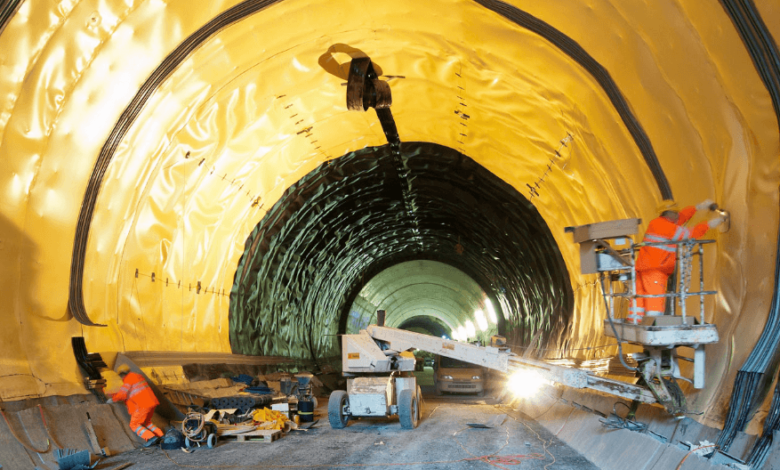Geotextil Impermeable: The Hidden Shield Beneath Our Infrastructure

Modern construction and environmental engineering projects demand materials that are both durable and efficient. One such material making a significant impact is the geotextil impermeable, a technical fabric designed to prevent water passage while offering mechanical reinforcement. Despite being hidden underground, its role is crucial in preventing erosion, managing water flow, and supporting infrastructure. But what exactly is it, and why has it become a necessity in today’s engineering solutions?
What Is Geotextil Impermeable?
A geotextil impermeable is a type of geotextile fabric designed to block the movement of liquids such as water or chemicals. Unlike permeable geotextiles that allow water to pass through while filtering particles, the impermeable version is constructed to act as a barrier. It is commonly used in civil engineering projects that require containment, separation, or environmental protection.
Typically made from polypropylene, polyethylene, or polyester, this fabric is chemically treated or laminated with membranes to enhance its impermeability.
How It Works
The primary function of an impermeable geotextile is to prevent the flow of fluids through the soil. The fabric creates a sealing layer that contains or redirects liquids. This is essential in projects like landfills, tunnels, canals, and retention ponds, where controlling seepage is critical.
Because geotextil impermeable also maintains a degree of flexibility and tensile strength, it not only resists fluid migration but also strengthens the soil and mitigates structural settlement or erosion.
Key Features
Understanding what makes geotextil impermeable a superior choice involves looking into its main characteristics:
- Waterproof: The most defining feature. It stops water infiltration entirely.
- Chemical Resistance: It resists degradation from chemicals commonly found in soil or waste.
- UV Resistance: If exposed, it can resist UV rays for prolonged periods without losing integrity.
- Easy Installation: Lightweight and rollable, it is simple to transport and install on-site.
See also: How AI is Transforming Business Strategy from Planning to Results
Types of Geotextil Impermeable
There are several types of impermeable geotextiles depending on material and application:
Coated Geotextiles
These are typically woven or nonwoven geotextiles coated with polymer membranes that seal the pores, making the fabric impermeable.
Laminated Geotextiles
A combination of fabric and a waterproof layer laminated together. They provide better tensile strength along with water resistance.
Bituminous Geotextiles
Often used in road construction, these geotextiles are impregnated with bitumen to make them water-repellent and enhance adhesion.
Each type serves unique purposes depending on the site conditions and environmental challenges.
Applications in Civil Engineering
Landfills and Waste Containment
Geotextil impermeable is widely used in landfills to line the base and cap of the site. It prevents leachate—a toxic fluid formed by decomposing waste—from seeping into groundwater.
Canals and Reservoirs
In irrigation or water storage projects, impermeable geotextiles are used as liners to prevent water loss through seepage.
Tunnels and Underground Structures
Waterproofing is essential in tunnels and basements. These geotextiles create a protective layer that prevents water ingress and ensures the structural integrity of the construction.
Road and Railway Construction
Used under roads or railway tracks in flood-prone areas geotextil impermeable prevents waterlogging and reduces damage caused by saturation.
Mining and Chemical Facilities
Where there’s a high risk of chemical leaks or acid water, impermeable geotextiles provide a safe and durable barrier between hazardous material and the environment.
Environmental Protection Role
As environmental regulations tighten, geotextil impermeable plays a growing role in sustainable construction. It prevents soil and groundwater contamination, ensuring that harmful chemicals, industrial waste, and stormwater runoff do not infiltrate ecosystems.
It is frequently used in wetlands protection, stormwater ponds, and agricultural wastewater treatment facilities. The material ensures that pollutants are contained and directed to proper treatment systems.
Advantages Over Traditional Materials
Before the rise of geosynthetics, clay liners or concrete barriers were commonly used. However, geotextil impermeable offers numerous benefits over these traditional solutions:
- Faster Installation: No curing time, unlike concrete.
- Lower Cost: Reduced labor and material costs.
- Adaptability: Flexible material can conform to natural ground surfaces.
Installation Process
The efficiency of a geotextil impermeable depends greatly on proper installation. Here is a general process:
- Site Preparation: The surface is leveled, and all sharp objects are removed to avoid puncturing the geotextile.
- Laying the Fabric: Rolls of geotextil are unrolled across the area and overlapped as specified.
- Sealing the Joints: Overlapping seams are welded or sealed using adhesives or heat fusion.
- Covering: A protective layer of soil, gravel, or concrete is placed over the fabric to prevent exposure.
Monitoring and quality control during installation are essential to prevent leaks and ensure long-term performance.
Future Trends
The field of geosynthetics is evolving rapidly. Innovations such as multi-functional geotextiles—which combine impermeability, filtration, and reinforcement—are entering the market. Smart fabrics embedded with sensors to monitor pressure or leaks are also being developed.
Biodegradable options for short-term containment or eco-sensitive projects are also gaining attention.
As infrastructure becomes smarter and more environmentally regulated, the role of geotextil impermeable will likely expand in both developed and emerging markets.
Conclusion
In a world facing environmental threats and rising construction demands, geotextil impermeable emerges as a smart, sustainable, and high-performance solution. From waste containment to flood control, it acts as a silent protector beneath our structures.
Understanding its features, applications, and limitations helps engineers and planners design more resilient, safer, and environmentally responsible projects. As innovation continues, these impermeable textiles will not only support infrastructure but also play a crucial role in protecting natural ecosystems.




